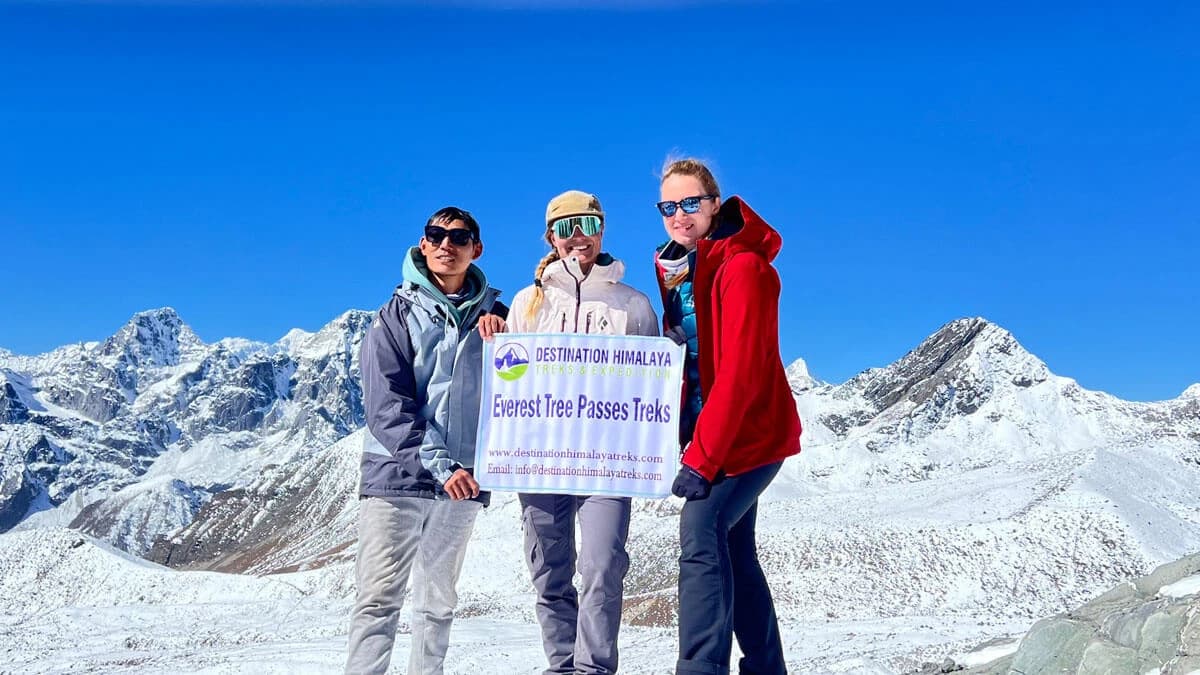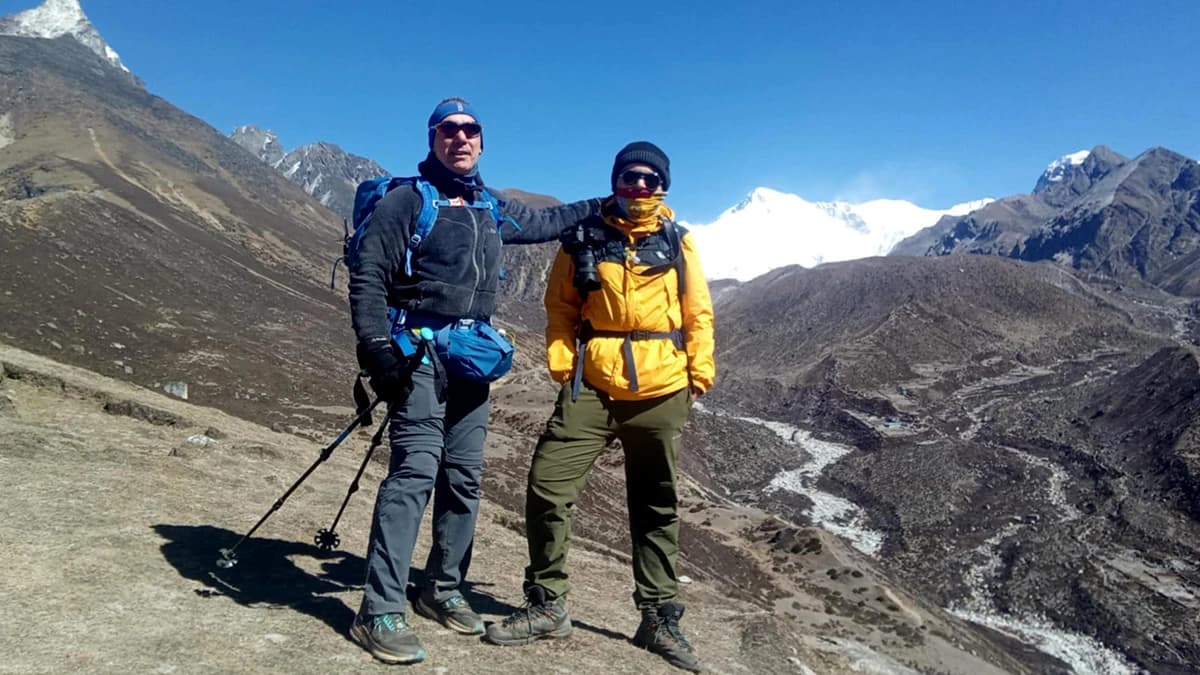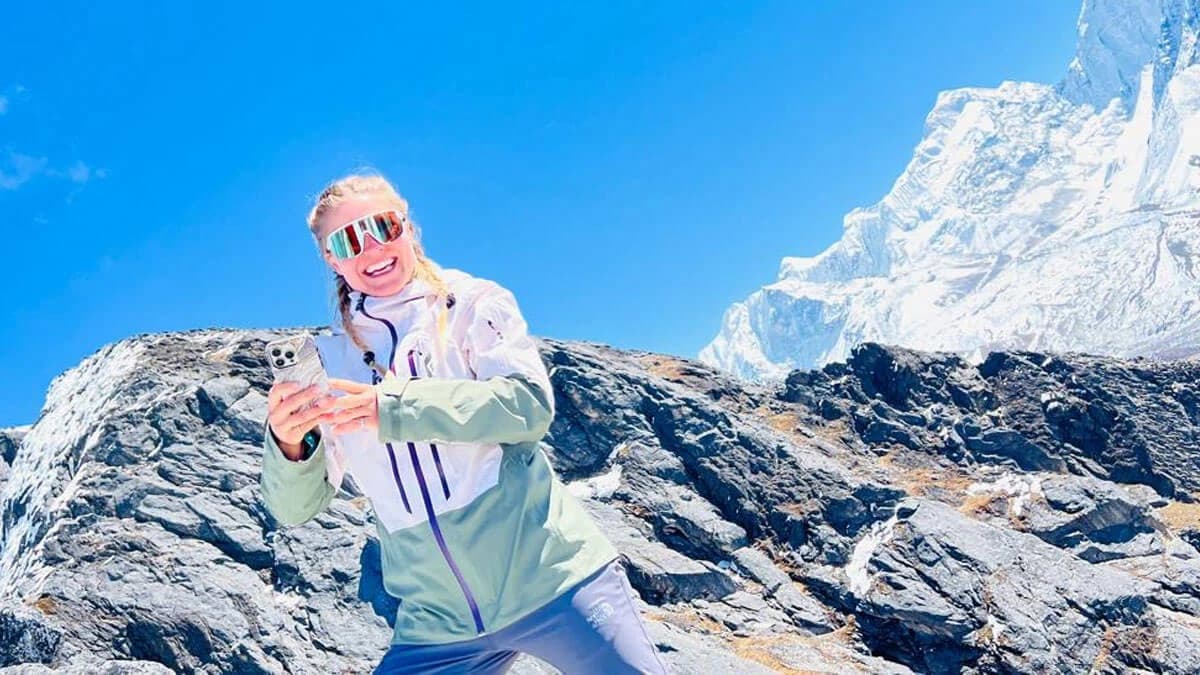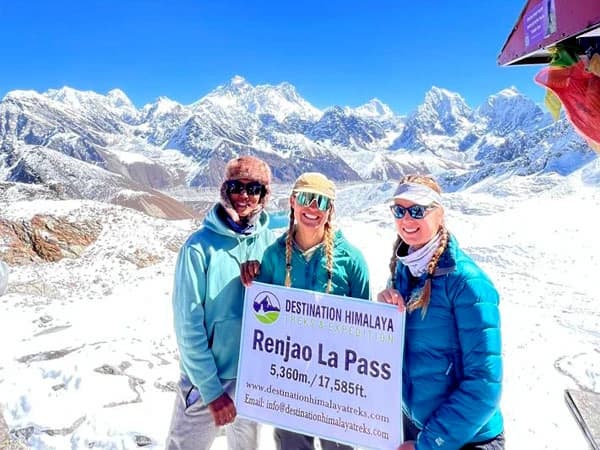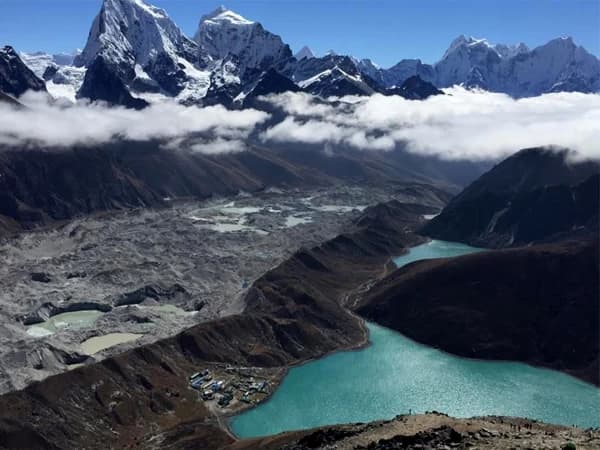Explore the enchanting Everest Three Passes that soars at a higher elevation exceeding 5000 meters, wander around Gokyo Valley, bypassing the ancient Sherpa trails, and also stand in the shadow of the iconic mountains, reaching the iconic Everest Base Camp (EBC) and Kalapatthar at the same time. This is the Everest 3 Pass Trek in an anticlockwise route, ensuring safety and the successful ascent simultaneously.
Everest High Passes Trek Anticlockwise Overview:
Three Passes Trek is one of the challenging yet top-notch destinations in Nepal, which ventures out to every corner of the Khumbu region and offers a crisp off-beaten adventure to thrill seekers as it passes through a rugged and ancient trailhead. This Everest Three Passes Trekking is set in an anticlockwise route that scales Kongma La Pass (5535 m), Cho La (5420 m), and finally Renjo La (5360 m), prioritising gradual ascent and also safeguarding that it offers you early access to EBC and Kala Patthar.
Following our 3 Passes Trek itinerary, you won't miss out on any highlighted aspects of the Everest region, in fact, it lets you cover and settle in at the Sherpa villages such as Thame, Khumjung, Thagnak, Dole, Lumde, Machermo, and Thame at the halfway point which goes all the way through remote areas showcasing an unique perspective of sherpa lifestyle and culture rather than the standard classic Everest Base Camp Trek.
However, if you are wondering whether this Everest High Passes Trek route excludes the classic trail, then do not settle back, as the first half of the trail meanders through Phakding right after the mesmerising flight to Lukla, entering the "Sagarmatha National Park." Traversing through Namche, Tengboche, Dingboche, Pangboche, Lobuche, before reaching the legendary Everest Base Camp - the foothill of the world's highest peak and Kala Patthar (5545 m) - the highest point of this entire trek, will surely demonstrate what the iconic route is like that everyone usually passes through.
After acing the Everest Three Pinnacles - Kongma La, Cho La, and Renjo La, this trek finally descends to Gokyo Valley, gazing over the holy hidden treasure of Gokyo Lakes (4500 to 5000 meters), via Ngozumpa Glacier - the largest glacier of the Himalayas and finally soars to the view point of Gokyo Ri - 5357 meters rewarding you with an unique perspective of the iconic mountains such as Cho Oyu, Makalu, Nuptshe, Lhotshe and even Mt Everest with deep cultural exploration of Sherpa community.
Even though this trek takes you to such a high elevation over 5000 meters in 6 vantage points, this expedition is safe to venture out if you have prior experience regarding how high-altitude treks are supposed to be. Meanwhile, beginners can proceed to the Anticlockwise Three High Pass Trek as it is properly customized with slow adaptation to rising high altitude, with three acclimatization days in between; at Namche, Dingboche and Gokyo Valley, letting you fully get used to of thin air and prepare for the upcoming challenging expedition on other days.
Note: If you are a new bie and never had any experiences on commencing at such high section then, what you can do is you can simply go for EBC with Gokyo Lake Trek that avoids the three high passes, so you can still fulfill your bucket list to venture at iconic landmark of the Himalayas.
Things that you explore during the Everest 3 Pass Trek
- Cross the exhilarating three high passes: Kongma La, Cho La, and Renjo La, feeling a sense of achievement
- Ascend to Kala Patthar- the last point that anyone can attain without any climbing permits to the world's highest peak
- Meander through the Sagarmatha National Park, exploring the Himalayan Flora and Fauna
- Explore several Sherpa villages with a great insight into Sherpa culture, highly influenced by Tibetan Buddhism
- Take an uphill walk to Gokyo Ri - 5357 meters via Ngozumpa Glacier
- Gaze over six holy Gokyo Lakes in a green emerald shade
- A day in the bustling town of Namche Bazaar and the Tibetan-influenced village of Dingboche
- Explore Gokyo Valley in depth with ancient Sherpa culture and tradition
- Reach Everest Base Camp (EBC) - the foothill of the world's highest mountain
- Take a heart-throbbing yet enchanting Lukla flight with the best views of iconic mountains
Why choose the anticlockwise route for the Everest Three High Passes?
There's no doubt that the Everest Three Passes Trek stands out to be one of the remarkable expeditions in Nepal that visits five top-notch trending spots in the landmark of the Himalayas, seriously a dream come true adventure for any thrill seekers that look forward to attaining the top point of Everest 3 pinnacles, Gokyo Ri, the lap of the none other than Mt. Everest and finally to the Kala Patthar - thee highest elevation that this trailhead reaches.
So, you might be quite familiar with how many routes are developing every day, and a new trailhead is always explored by several hikers in this iconic Khumbu region. Just like that, there are 2 routes to do the Everest 3 pass Trek, firstly the counterclockwise route and the other the anticlockwise route, so you might feel hassled about which trailhead to opt for and also what the exploration and benefits of opting for the Anticlockwise Everest High Passes Trek are. Here are four compelling reasons why the Anticlockwise Everest High Passes Trek is considered safer, offers deeper exploration, and increases your chances of a successful adventure than any other pathways:
Better Acclimatization and Safety
Selecting the Anticlockwise route is widely preferred and simply enriches the probability of succeeding the trek to Everest Three Passes as it crosses the Kongma La first, the most challenging section of the two passes, after just navigating through Namche Bazaar and Dingboche - 2 acclimatization points. This way, it reduces the risk of Acute Mountain Sickness (AMS) due to gradual ascent of only 400 to 500 meters, firmly adopts the rising revelation and builds confidence for the remaining passes, making the trek safer and more manageable, even for beginners who dream of acing this height over 5000 meters.
Early Access to Everest Base Camp and Kalapatthar: Strategic Success Journey
One of the main reasons to choose the Everest High Passes Trek anticlockwise itinerary is that after crossing Kongma La Pass, the route ascends directly to Everest Base Camp (EBC) and Kala Patthar, two of the trek’s highest and most iconic highlights, allowing you to experience these celebrated landmarks soon after completing the most challenging pass at the first half of the trail. Sometimes, what happens is due to some unfortunate weather, or any conditions such as high snowfall (usually happens in monsoon and winter), which creates a blockage to high passes that sadly might even ruin the expedition in the middle of nowhere.
Going by this way: Kongma La - EBC - Kalapatthar - Cho La - Renjo La minimizes the risk of the trek being disrupted in remote sections and also reaches the EBC and KalaPatthar- the main trail without being forced to completely re-route, which can lead to flight delays and cancellations.
Deeper Exploration of Gokyo Valley with Ancient Sherpa Villages
Trekking the Everest Three Passes in a counterclockwise direction allows you to conclude the trip with relaxation at the Gokyo region without feeling hassled or rushed to reach the pinnacle, hence you can explore the Gokyo valley with a free mind. In between, you'll pass by the ancient trailhead after succeeding the thrilling high passes via Sherpa villages such as Machhermo, Dole, Thame, Lumde, Thaknak, showcasing the deeper cultural insights of Sherpa locals without any panic mode. Reaching Gokyo Ri (5357 m), via bypassing the Gokyo Lakes and experiencing the surrounding mountain views such as Lhotshe, Cholatshe, Cho Oyu, Makalu, and many others, with the fascinating view of Nzogumpa glacier - the highest glacier amid the himalayas serves as a perfect height to finalize our challenging anticlockwise expedition.
Flexibility and High Success Rate
The Everest Three Passes Trekking route, in an anticlockwise contributes significantly higher rate to the expedition comparatively as it reaches the main sections of Kongma La, Everest Base Camp and Kalapatthar Thus, in case of bad weather or any emergency occur if it arises, you do not have to avoid these highlighted section as you'll be already completed the journey in the 1st half. Besides, if the situation gets worse, then you can slightly skip the Gokyo Lake and Gokyo Ri section without missing out on the main destinations. However, opting for this adaptability increases your chances by 99% to succeed in the trip and complete the final venture without any fuss.
Hence, we also do offer the Three Passes Trek in a clockwise direction, if you want to take an ascent with ease by following Renjo La - Cho La and Kongma La and later reach EBC.
Why trek to Everest's three pinnacles with Destination Himalaya Treks and Expedition?
With experience serving many hikers across the globe, we take pride in ensuring that your trek becomes a hassle-free journey and you can thoroughly enjoy every step you take within every region of Nepal. Destination Himalaya Treks has been operating tours, treks, and peak climbing for more than 15 years, hence, our DHT Team is highly experienced and possesses ample experience to make your trip to the Himalayas safe, secure, with top-notch guides and porters.
Our trekking guides are highly experienced, licensed, and also fluent in English and other languages. On top of that, they've even assisted in many climbs such as Mera Peak, Island Peak, and Lobuche Peak, or you can say every corner of the Khumbu region, from basic to top heights. Our Everest Three Passes Trek costs all your essentials, and carries a great transparency with no hidden charges, hence, whatever you see, you get it! There is nothing called extra or any other charges going out of the package. To know more in-depth, you can check our cost details at the top of the page.
Besides, our itinerary can be easily customizable; you can craft your packages however you like, shortening or lengthening the duration, or any other route that you love to meander from, and the best part is! The cost can be fit according to your estimation. Also, we offer many other additional benefits to ensure that your trek becomes even more prosperous within the trekking trail, or before and after the expedition.
- Staycation if you are thinking about staying for extra 1-2 days, we offer a free complimentary stay for 2 days at our own company "Hotel Bihani".
- Free Seven Sightseeing Tour to UNESCO Listed World Heritage Sites within Kathmandu, Bhaktapur, and Patan Valley
- Free Airport Pick up and Drop off via private vehicle with the assistance of a guide
- Complimentary welcome and Farewell Dinner at the Nepalese Fine Dining restaurant with a cultural performance
- Detailed Trip Briefing via online before the booking and IN-PERSON Briefing upon arrival
- 24/7 hour communication to track your safety en route (trekking trail), via Email, Viber, WhatsApp, Direct Call at +977 9851016814 or mail info(a)destinationhimalayatreks.com
- Basic First Aid Kit, including the water purification tablet to purify the water
- Oximeter- to keep on track how your pulse rate is working and ensure that your body is adapting to the rising elevation
- Destination Himalaya Cap, T-shirt, Trip Map, Duffle Bag, Jacket, and Sleeping Bags (upon request)
- Free Luggage Excess Storage even after the trip gets completed if in case you don't have the place to fit or keep your luggage safe
